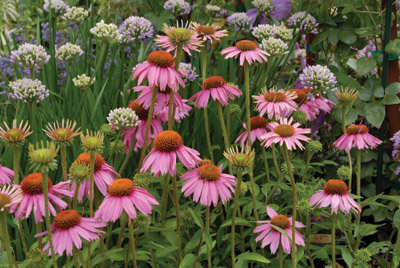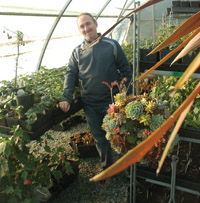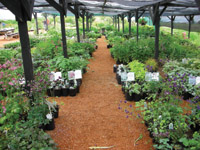
Gary Lewis, a self-proclaimed “well-educated farmer” with a small
throwback retail nursery, is the new Canadian region director of the
Perennial Plant Association (PPA).
Gary Lewis, a self-proclaimed “well-educated farmer” with a small throwback retail nursery, is the new Canadian region director of the Perennial Plant Association (PPA).
A voracious gardener since his early teens with a bachelor’s degree in conservation biology, Lewis was “within three months” of completing his master’s degree in plant ecology at the University of British Columbia in the spring of 2004 when he received an e-mail advising him of a small nursery for sale in Richmond (part of metro Vancouver).
 |
| A sampling of Phoenix Perennials. Photo courtesy Phoenix Nursery. |
“Within two weeks I owned it,” Lewis recalls, taking over Phoenix Perennials (now known as Phoenix Perennials & Specialty Plants) on his 28th birthday, March 18, 2004. He took the season off to run the nursery before completing his master’s degree that December.
“There aren’t a lot of nursery owners with a master’s degree in botany,” he chuckles, saying that gives him the tools to “push the limits” in horticulture. “It’s a good synergy of interests and experience.”
A REGIONAL DESTINATION FOR VANCOUVER GARDENERS
Phoenix has grown exponentially over the past six seasons, Lewis noting the nursery is up “1,000 per cent” over where he started. “Our customer base has expanded greatly. We’re becoming a regional destination nursery for greater Vancouver. We have clientele who come to us from as far away as the Sunshine Coast, Vancouver Island, Washington and even the B.C. Interior.”
While most customers are retail shoppers, his clientele includes a few landscapers who come for plants they can’t get elsewhere.
 |
|
| New Canadian region PPA director Gary Lewis. Photo courtesy Phoenix Nursery. |
Phoenix Perennials is “kind of unconventional” in that it is a retail nursery that grows “60 to 70 per cent” of its own plants. As a result, Lewis employs both a retail manager and a production manager. Production staff work nine and a half months each year, while retail staff work eight and a half months each year. The nursery is open from late February to the end of October.
“The markups are better with retail but you have to spend more time with the customers. It’s a trade-off,” he admits, but one which he does not plan to give up. “I’m a people person. I love the enthusiasm of the home gardeners.”
The nursery is only about an acre in size, with half the area uncovered and dedicated to retail and the other half (two 100-foot cold frame greenhouses with only emergency propane heat, and a small 20×24-foot propagation house with “a little bit of heat”) used for growing.
“What we have is pretty low tech,” Lewis admits, saying that is appropriate since their plants are grown for home gardeners who also do not have fancy greenhouses.
OFFERING LARGE SELECTION IN PERENNIALS, SPECIALTY PLANTS
What they do have is selection: they add about 500 plants each year and now offer about 4,000 different perennials and specialty plants.
“We have one of the largest, if not the largest, selections in Canada,” Lewis states proudly.
He focuses on three types of plants:
- Garden stalwarts – tried and true plants which are “just great plants.”
- Cutting edge new perennials – “We try to be among the first in Canada with new plants. We bring them in the same time as the wholesale growers. If they catch on, we tend to stop growing them and get them from wholesale growers.”
- Rare and unusual plants – Lewis spends much of his winters travelling the world in search of different plants, such as dwarf conifers, unusual Japanese maples, and rare groundcovers. For example, he visited Taiwan in the fall of 2008, returning with a collection of seeds the nursery is now propagating.
 |
|
| At home in a cold frame last fall. Photo by David Schmidt |
“We will bring in plants from Europe, India, Japan, South Africa and the United States and seeds from all over. I look for plants of horticultural merit that might be unknown or poorly known. I also look for different forms of plants, such as one that’s variegated or has a different colour than the usual.”
Leading his successes are the hellebores. He grows 90 different kinds and starts his retail season with a “Hellebore Hurrah” that last year drew over 600 customers to his opening weekend. “People go crazy for them. They’re more expensive but people don’t flinch.”
Other successes include cobra lilies, the Kleim’s Hardy gardenia, the Jolly Bee Geranium, new echinacea varieties, and the Coral Bells heuchera.
“Heucheras had saturated the market, but there has been a renewed interest in them because of the new cultivars which have come out in the past couple of years,” Lewis notes.
NEW PLANTS: THEY CAN’T ALL BE WINNERS
Not every new plant is a success.
“Sometimes we go too far beyond our client base. Either the plants are too esoteric or we haven’t educated our clients about them. They don’t understand that some early introductions are just that.”

|
|
| Touring the shade plant sales area.
|
The PPA is best known for its Perennial Plant of the Year program, which each year selects one plant for special recognition. The PPA starts with a list of nominees, one of which is selected by membership vote and then advertised to both industry and the general public.
“The program serves us from a retail perspective,” Lewis says. “It’s a great way to help us sell something which we know will perform for our clients.”
Lewis got involved with the PPA at the invitation of Janet Anderson of Ontario, a previous PPA president, and a person he once worked for.
He calls the PPA directorship “a great opportunity for professional development.”
PPA PLANS TRIALLING OF HEUCHERA, ECHINACEA
Lewis has been appointed chair of the PPA retail committee, saying one of his aims is to add value for retail PPA members. He has already begun by editing and contributing to a new retail column in the PPA journal. He is also helping develop a new trialling program for heuchera and echinacea.
“We hope to launch the program in the next year or so,” Lewis says, believing the trials will help wholesale growers make better decisions on what to grow and give retailers more insight into what to sell.
The PPA is just one of his industry involvements. He is a member of the Elizabeth C. Miller Botanical Garden Great Plant Picks perennial and bulb committee. The GPP program is designed to create a list of plants particularly suited to the Pacific Northwest. He is also actively involved in E-Flora B.C., which is creating an online atlas of native B.C. plants.
One reason Lewis carries so many different plants is so he can give people the “right plant for the right place. We tell our customers to work with the conditions they have and find plants that will adore those conditions. Don’t choose plants first and try to alter conditions to suit them. Ecology in a garden is a paradigm shift in people’s minds, but when you explain the concept, it makes sense to them and they get excited about it.” ■
David Schmidt is a freelance writer and photographer in British Columbia.
Print this page